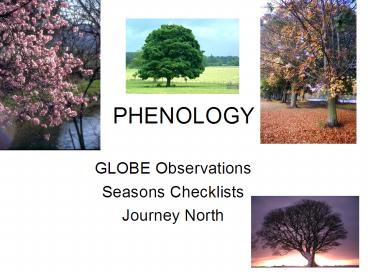PHENOLOGY PowerPoint PPT Presentation
1 / 16
Title: PHENOLOGY
1
PHENOLOGY
- GLOBE Observations
- Seasons Checklists
- Journey North
2
PHENOLOGY
- What is phenology?
- The seasonal timing of life cycle events
- Why study phenolgy?
- Looking at seasonal changes focuses students on
earth systems phenomena earth tilt, insolation,
rotation and revolution, equinoxes and solstices,
climate and biomes distribution, etc. - Focused observations, predictions, analysis are
all part of scientific literacy. - Students need to go outside and do science.
3
How to begin
- Discuss seasonal changes.
- Look at Phenology Worksheets.
- Calculate photoperiod.
- Measure shadows.
- Balance an egg.
- Begin monthly Phenology checklists
4
Seasonal Changes for Fall
- Sunlight decreases, days get shorter
- Daylight Saving Time ends
- Temperature drops, water freezes (occasionally)
- Plants change color, lose leaves, drop nuts, go
dormant - Crops are harvested
- Animals change their behavior migrate in or out,
hibernate, get furry coats, store food
5
Seasonal Changes for Spring
- Sunlight increases, days grow longer
- Temperatures increase
- Daylight Saving Time begins
- Plants begin to grow again, bud, leaf out, green
up, produce flowers - Crops are planted
- Animals get more active, migrate in or out, build
nests, have babies - School ends!
6
Phenology Worksheets
- Calculate photoperiod.
- Measure length of shadow at noon.
- Measure (or look up) temperature high/low/
average for that day. - Observe trees and other plants.
- Observe animal behavior.
- Look up annual precipitation, including snow if
applicable. - Record measurements/observations in science
notebooks. - Create seasonal display of artifacts if desired.
7
Photoperiod
- Photo light, period interval of time
- Photoperiod is the amount of daylight in a day,
or the time interval between sunrise and sunset. - Get sunrise/sunset times from your local TV
channel or newspaper, or go to - http//aa.usno.navy.mil/data/docs/RS_oneDay.php
- Calculate photoperiod in hours and minutes.
- Example sunrise 640 am/sunset 450 10 hours
and 10 minutes. Hints for figuring in TG. - Graph results over time.
8
Examples of graphs
9
Measuring Shadows
- Begin with measuring the length of the shadow of
a meter stick over the course of a day. - Shadows will be longer in the morning and late
afternoon, will be shortest at noon, and will
seem to move in a semi-circle.
10
Measuring Shadows
- Using the same measuring stick in the same
location at solar noon, measure the length of the
shadow over the course of a year. Shadow will be
longer in the winter and shorter in the spring. - Chart results and enter in science notebook.
11
Balance an egg
- Myth Busters 101 Is there some special force
that allows eggs to balance on end at the
Equinox? - Equi equal nox night Equinox
- Twice a year, around March 20 and September 22)
the Earth experiences Equinox. - All over the Earth, there are equal hours of
daylight and darkness on those days. - Some people believe that on those special days of
global balance, raw eggs will stand on end.
12
Try It!
- On a smooth flat surface, have students try to
balance the eggs on end. Some will be
successful!!! - Now for the myth-buster part Try this
experiment once a week for 2 weeks before the
Equinox, on the Equinox, and for 2 weeks after
the Equinox. - More myth-busters Have the students think of
other myths or folklore and either research or
devise a way to test them.
13
Fall Phenology Worksheet
- On your first visit (hopefully in August)
- a. calculate photoperiod
- b. measure shadowstick around noon
- c. measure or look up temperatures
- d. adopt a tree (flag, identify, photograph,
draw pictures, observe leaves, berries, nuts) - e. choose other plants to observe
- f. observe animals or signs of animals
- g. look up climate data
- h. collect artifacts for seasonal display, if
desired - Record data and observations in science
notebook.
14
Return on the Fall Equinox (September 23), on
October 17, on November 21, and on Winter
Solstice December 22 and observe again.
(If you cant go out on those exact dates, go as
close as possible youre tracking trends.)
Think about planting a bulb garden and/or
including flowering dogwood or redbud in your
adopted trees to participate in spring Leaf
Out. Consider tracking animal migration.
15
Spring Phenology Worksheet
- Dates are January 20, February 20, March 20
(Spring Equinox), April 20, May 20 - Photoperiod and shadow calculations are the same
- Temperature observations include date of last
frost, last low temperatures, ice-out. - Plant observations include leaf-out, first
blossoms, first flowers - Animal observations include first sightings of
earthworms, frogs, robins, hummingbirds,
monarchs, etc.
16
Journey North
Bald eagles, frogs, leaf-out, hummers, monarchs,
robins, tulips, photoperiod, barn owls, gray
whales. Also caribou, loons, wolves, manatees and
more!
- http//www.learner.org/jnorth/tm/
- Includes many different projects to participate
in, background lessons, challenges, maps,
animations--- ALL FREE! - Integrate technology tell your computer teacher!

